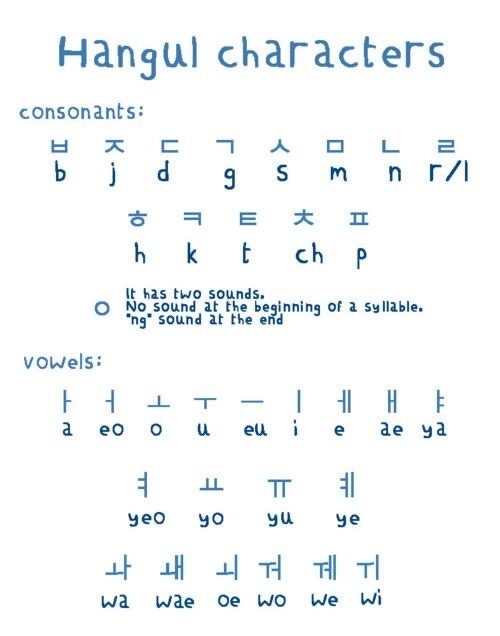Text
Core Korean (핵심 한국어)
핵심 = core
한국어 = korean
───✱*.。:。✱*.:。✧*.。✰*.:。✧*.。:。*.。✱ ───
Greetings 인사말:
Formal Greetings 형식적인 인사말
안녕하십니까 = Hello
Polite Greetings 존댓말 인사말
안녕하세요 = Hello
오랜만이에요 = Long time no see
실례요/실려합니다 = Excuse me
Casual Greetings 판말 인사말
안녕 = Hi
야! = Hey
오랜만이야 = Long time no see
저기요! = Excuse me!
__________________________________________
Formalities 격식:
Formal Formalities 형식적인 격식
안녕하십니까? = How are you?
Polite Formalities 존댓말 격식
잘 지내셨어요 = Have you lived well?
어떻게 지내셨어요? = How have you been?
Standard Formalities 표준 격식
잘 지냈어요? = How are you?
잘 있었어요? = Have you been well?
어떻게 지내세요? = How have you been?
Casual Formalities 반말 격식
잘지네냐? = How are you?
잘지냈어 = How are you?
무슨 일이야? = What’s up?
모해? = Whaddup?
(^_^)
뭐하는 거야? = What are you doing?
뭐하니? = Whatcha doing?
Responses 응답
괜찮아요 = I’m fine
괜찮아요. 어떻게 지내? = I’m fine. How are you?
괜찮아요. 잘 지내요? = I’m fine. Are you doing well?
전 괜찮아요 / 난 괜찮아 = I’m okay, but I am not sure about other (family members, etc.)
(^_^)
잘 지내요 = I’m great
기분이 별로예요 = Not good/so-so
나쁘지 않아요 = Not bad
졸려요. (어제 늦게까지 공부를 했어요) = I’m sleepy (because I studied late last night ) 
피곤하다 = I’m tired
(^_^)
너는? = And you?
물어봐 줘서 고마워요 = Thank you for asking
__________________________________________
Farewells 이별:
Formal Farewell 형식적인 이별
안녕히 계십시오 = Saying goodbye to the one staying
안녕히 가십시오 = Saying goodbye to the one leaving
Polite Farewell 존댓말 이별
안녕히 계세요 = Saying bye to the one staying (shorter version: 계세요)
안녕히 가세요. Saying bye to the one leaving (shorter version: 가세요)
조심히 가세요 = Saying have a safe journey to the one leaving
조심히 계세요 = Saying have a safe journey to the one staying
조심히 들어가세요 = Saying have a safe journey to the one who is leaving
잘 들어가세요 = Saying bye when you and another are leaving at the same time
(^_^)
또 봐요 = See you
나중에 또 봐요 = See you later
다음에 또 봐요 = See you next time
Casual Farewell 반말 이별
잘 있어 = Bye to the one staying
잘 가 = Bye to the one leaving
(^_^)
조심히 = Have a safe journey
보다 = See ya
안녕 = Bye
__________________________________________
Meeting People 사람 만나기:
Formal Meeting 형식적인 만나기
저음 뵙겠습니다 = I am meeting you for the very first time (literal translation)
Polite Meeting 존댓말 만나기
만나서 반갑습니다 = It’s very nice to meet you
반가워요 = It’s nice to meet you
잘부탁드립니다 = Please look after me
Casual Meeting 반말 만나기
만나서 반가워 = Nice to meet you
__________________________________________
Introducing Yourself 자기 소개:
Formal Introduction 형식적인 소개
안녕하세요, 저는 (이름)입니다. 처음 뵙겠습니다 = Hello, my (name) is. I am meeting you for the first time
Polite Introduction 존댓말 소개
안녕하세요, 저는 (이름)입니다. 만나서 반갑습니다 =Hello, my name is ____ it’s very nice to meet you
Casual Introduction 반말 소개
안녕, (이름)야. 반가워 = Hi, my name is ____ it’s nice to meet you
(이름)야 = My name is ____
Neutral Introduction 중립 소개
제 소개를 하겠습니다 = I am going to introduce myself
(장소) 서 왔습니다 = I am from (place)
(나이) 살 입니다 = I am (age) years old
학생입니다 = I am a student
(직장)-imnida = I am a (occupation)
(지속시간) 동안 공부했습니다 = I have been learning Korean for (time duration)
__________________________________________
Thanking 감사하는:
Formal Thanking 형식적인 감사하는
대단히 감사합니다 = Thank you very much
Polite Thanking 존댓말 감사하는
감사합니아 = Thank you
고맙습니다 = Thank you
Casual Thanking 반말 감사하는
고마워요 = Thank you
고마워 = Thanks
(^_^)
고맙지만, 괜찮아요 = Thank you, but it’s okay
아니(아/요), 괜찮아요 = No “thanks” it’s okay
Modifiers 수정자
Consider using these terms before saying thank you
진짜 / 정말 = Really
너무 = Too ‘너무’ in Korean is used to express that someone feels grateful very much.
Formal Response 형식적인 응답
천만에요 = You are welcome
Polite Response 존댓말 응답
별말씀을요 = Don’t mention it
아니에요 = No problem
__________________________________________
Apologizing 사과하기:
Formal Apology 형식적인 사과하기
죄송합니아 = I am very sorry
사과하세요 = Please apologize
사과드리세요 = Apologize to that person
Polite Apology 존댓말 사과하기
죄송해요 = I apologize 
미안해요 = I am sorry 
사과해요 = Please apologize
사과드려요= Apologize to that person
Casual Apology 반말 사과하기
미안해 = Sorry
사과해 = Apologize
사과드려 = Apologize to that person
Modifiers 수정자
Consider using these terms before apologizing
진짜 / 정말 = Really
#korean vocabulary#korean#learn korean#south korea#hangul#langblr#language#languages#travel#한글#한국어 어휘#한국어 공부하기
57 notes
·
View notes
Text
The Names of the Korean Alphabet (한글 이름)
───✱*.。:。✱*.:。✧*.。✰*.:。✧*.。:。*.。✱ ───
Consonants 자음:
ㄱ = 기역
ㄴ = 니은
ㄷ = 디귿
ㄹ = 리을
ㅁ = 미음
ㅂ = 비읍
ㅅ = 시옷
ㅇ = 이응
ㅈ = 지읒
ㅊ = 치읓
ㅋ = 키읔
ㅌ = 티읕
ㅍ = 피읖
ㅎ = 히읗
Notice that ㄱ / ㄷ / ㅅ are the only consonants that don’t follow the 이응 pattern at the end.
Paired Consonants 쌍 자음:
ㄲ = 쌍 기역
ㄸ = 쌍 디귿
ㅃ = 쌍 비읍
ㅆ = 쌍 시옷
ㅉ = 쌍 지 읒
Notice that ㄲ /ㄸ /ㅆ are the only paired consonants that don’t follow the 쌍 이응 pattern at the end.
Vowels 모음:
Vowels are pronounced as they’re written (they don’t have names)
0 notes
Text
Hangul Reference (한글 참고)
한글 = hangul, Korean alphabet
참고 = reference
───✱*.。:。✱*.:。✧*.。✰*.:。✧*.。:。*.。✱ ───
Extra Translations 특별한 번역:
특별한 = extra
번역 = translations
문자 = characters
자음 = consonants
모음 = vowels
Note 노트:
If ㄷ, ㅅ, ㅈ, ㅊ, ㅌ, ㅎ are the final consonant, they sound like short 'ㄷ'

1 note
·
View note